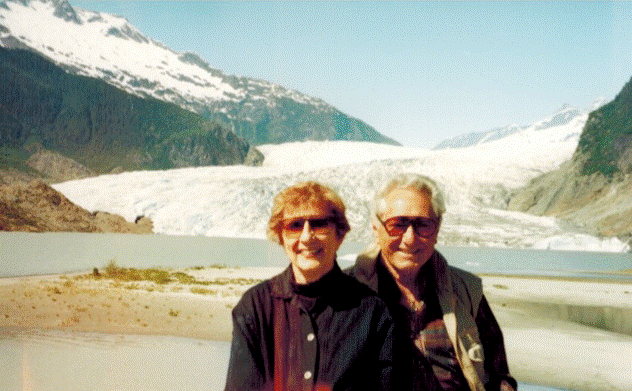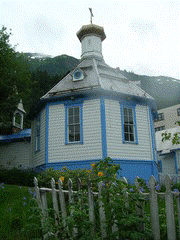BY: JANET STEINBERG
Juneau, Alaska’s capital city, is located on the pristine
waterfront of Gastineau Channel in
Southeast Alaska’s Inside Passage. With its backdrop of
grand mountain peaks, Juneau has billed itself as
“Alaska’s Peak Experience”.
The
good natured people of Juneau shrug their shoulders at its
dampness and joyously welcome you to their Rain Festival which runs
from January 1 through December 31 each year. After a few
minutes of grumbling, even the visitors forget about the precipitation and
go about the business of exploring the historic streets of the state
capital.
good natured people of Juneau shrug their shoulders at its
dampness and joyously welcome you to their Rain Festival which runs
from January 1 through December 31 each year. After a few
minutes of grumbling, even the visitors forget about the precipitation and
go about the business of exploring the historic streets of the state
capital.
When
Old Sol does make one of his brief appearances, as it did (for
an entire day) when my cruise ship brought the sun along,
the town declares an arbitrary sun-break holiday.
Old Sol does make one of his brief appearances, as it did (for
an entire day) when my cruise ship brought the sun along,
the town declares an arbitrary sun-break holiday.
Juneau, the first city founded after the purchase of Alaska from Imperial Russia
in 1867, had its beginnings in gold. In 1880, Joe Juneau and
Richard Harris struck gold and started what came to be known as the
Alaska-Juneau Mine. Rusty remnants of the mine can
still be seen on the hillside.
The
city, confined as it was by the sea and Mt. Juneau towering behind
it, was destined to grow. Today clusters of colorful homes
ascend the slopes of the mountain. The only place for Juneau to
go is up.
city, confined as it was by the sea and Mt. Juneau towering behind
it, was destined to grow. Today clusters of colorful homes
ascend the slopes of the mountain. The only place for Juneau to
go is up.
The
old and the new are strikingly contrasted in this modern
city. The sleek Federal Office Building rises
above turn-of-the-century houses. The gingerbread
Victorian, onion-domed, octagonal-shaped, blue and
white clapboard St. Nicholas Orthodox
Church (1894) contains interesting icons and vestments of the
past. This tiny church, located at 5th Street between
Franklin and Gold, is one of the oldest places of worship in
South-east Alaska.
old and the new are strikingly contrasted in this modern
city. The sleek Federal Office Building rises
above turn-of-the-century houses. The gingerbread
Victorian, onion-domed, octagonal-shaped, blue and
white clapboard St. Nicholas Orthodox
Church (1894) contains interesting icons and vestments of the
past. This tiny church, located at 5th Street between
Franklin and Gold, is one of the oldest places of worship in
South-east Alaska.
The
history of Alaska comes alive in The House Of Wickersham, one of the
first houses built in Alaska under the U.S.
flag. The former residence of the late James Wickersham, a
pioneer federal judge, is perched high atop Seventh Avenue and
commands a panoramic view of Gastineau Channel. The
house contains an exciting collection of historic memorabilia
including a genuine Chickering Grand piano from the
1800’s. Call to check on its hours. (907) 586-9001.
history of Alaska comes alive in The House Of Wickersham, one of the
first houses built in Alaska under the U.S.
flag. The former residence of the late James Wickersham, a
pioneer federal judge, is perched high atop Seventh Avenue and
commands a panoramic view of Gastineau Channel. The
house contains an exciting collection of historic memorabilia
including a genuine Chickering Grand piano from the
1800’s. Call to check on its hours. (907) 586-9001.
The
Alaska State Museum has an outstanding collection of
Eskimo, Tlingit, Athapaskan and Aleut artifacts. The ramp
ascending to the second floor winds around a lifelike exhibit
featuring a 2-story spruce tree and six bald eagles.
Alaska State Museum has an outstanding collection of
Eskimo, Tlingit, Athapaskan and Aleut artifacts. The ramp
ascending to the second floor winds around a lifelike exhibit
featuring a 2-story spruce tree and six bald eagles.
The
Alaskan Hotel and the Red Dog Saloon are also must-sees in
Juneau.
Alaskan Hotel and the Red Dog Saloon are also must-sees in
Juneau.
The Alaskan
Hotel, opened in 1913, is the oldest operating hotel
in Juneau. Renovated in its original Alaskan Victorian
style, the hotel is an excellent architectural example of
the transitional change between the 19th and early 20th century.
Bartenders at the hotel’s historic bar pour booze behind a
turn-of-the-century bar flanked with pseudo-Victorian lampposts and
Tiffany Lamps. The Alaskan Hotel is on the National
Register of Historic Places.
Hotel, opened in 1913, is the oldest operating hotel
in Juneau. Renovated in its original Alaskan Victorian
style, the hotel is an excellent architectural example of
the transitional change between the 19th and early 20th century.
Bartenders at the hotel’s historic bar pour booze behind a
turn-of-the-century bar flanked with pseudo-Victorian lampposts and
Tiffany Lamps. The Alaskan Hotel is on the National
Register of Historic Places.
The Red Dog Saloon, with its swinging doors and sawdust
floors, conjures up memories of Wyatt Earp and Juneau
Hattie. In fact, Earp’s sixshooter is among the
memorabilia mounted on every available inch of wall space in The Red
Dog. Passing through the swinging doors, a honky-tonk
piano player pounds out a toe-tapping
tune. Snow shoes, a gun collection, moose, caribou and
mountain goat heads adorn the walls. The upper portion of
a 1450-pound grizzly guards this world-renowned bar.
 |
| RED DOG SALOON |
The
tin-walled Imperial Bar is the oldest, and longest, bar in
Alaska. Some twenty-two stools line the 63-foot bar which
attracts at least forty leaners on a busy night. Built in 1890
over the tidal flats, the Imperial is the oldest bar in Alaska still
remaining in its original spot. This granddaddy bar, with its
authentic frontier atmosphere, has been frequented by members of the same
family for nigh on a century. Called The Louvre, until the
1930’s, the ambiance is reminiscent of the days when saloons were really saloons.
At The Imperial, I learned an old Alaskan drinking custom. To
“timber the bell” is to ring the big brass bell in the center of
the bar, thereby announcing your intention to buy drinks for the
house. I strongly recommend that you don’t ring the bell if you
don’t mean business.
tin-walled Imperial Bar is the oldest, and longest, bar in
Alaska. Some twenty-two stools line the 63-foot bar which
attracts at least forty leaners on a busy night. Built in 1890
over the tidal flats, the Imperial is the oldest bar in Alaska still
remaining in its original spot. This granddaddy bar, with its
authentic frontier atmosphere, has been frequented by members of the same
family for nigh on a century. Called The Louvre, until the
1930’s, the ambiance is reminiscent of the days when saloons were really saloons.
At The Imperial, I learned an old Alaskan drinking custom. To
“timber the bell” is to ring the big brass bell in the center of
the bar, thereby announcing your intention to buy drinks for the
house. I strongly recommend that you don’t ring the bell if you
don’t mean business.
If you’re adventurous, ask the bartender to mix you an iceworm
cocktail, inspired by Robert W. Service’s “Ballad of the
Iceworm Cocktail”. (I gave her my recipe smuggled out
of the Baronoff Hotel’s Bubble Room some 25 years ago.) It is a
somewhat nauseous looking concoction of vodka, blue Curacao, sour
mix, tonic and with or without green spaghetti to simulate the worm.
But
don’t let those native “sourdoughs” laugh at you when you
mention the iceworm. There really is an
iceworm. However, it doesn’t swim in cocktails and it doesn’t
give glaciers their blue color. Just mention the
scientific name Mesenchytraeus Solifugus to them and you
won’t be teased about iceworms again.
don’t let those native “sourdoughs” laugh at you when you
mention the iceworm. There really is an
iceworm. However, it doesn’t swim in cocktails and it doesn’t
give glaciers their blue color. Just mention the
scientific name Mesenchytraeus Solifugus to them and you
won’t be teased about iceworms again.
Alaska’s
capital city of Juneau is completely landlocked with no roads
of access or egress. You can drive out of town for
45-miles and that’s it. However, there are two
not-to-be-missed places that we visited by car or tour bus.
capital city of Juneau is completely landlocked with no roads
of access or egress. You can drive out of town for
45-miles and that’s it. However, there are two
not-to-be-missed places that we visited by car or tour bus.
First,
the rustic Log Chapel by the Lake (Auke Bay). This
imposing structure—of 48-foot logs, huge twin beams and
hand-split shake roof—suggests stability and firmness of
faith. The large picture window—overlooking a lake, forested
slopes, a massive glacier and mountain
meadow—emphasizes awareness. The simplicity of
the furnishings suggest the desire for tolerance and strength.
the rustic Log Chapel by the Lake (Auke Bay). This
imposing structure—of 48-foot logs, huge twin beams and
hand-split shake roof—suggests stability and firmness of
faith. The large picture window—overlooking a lake, forested
slopes, a massive glacier and mountain
meadow—emphasizes awareness. The simplicity of
the furnishings suggest the desire for tolerance and strength.
 |
| CHAPEL BY THE LAKE |
Second,
the Mendenhall Glacier, the original drive-up-to glacier and probably
the most famous in the world. This great river of ice,
stretching 12-miles long, spills over onto the floor of the
Mendenhall Valley.
the Mendenhall Glacier, the original drive-up-to glacier and probably
the most famous in the world. This great river of ice,
stretching 12-miles long, spills over onto the floor of the
Mendenhall Valley.
 |
| AUTHOR AND HUSBAND AT MENDENHALL GLACIER |
The
Mendenhall Glacier is not just a gigantic piece of ice. It
is a dynamic, constantly moving force that has carved the landscape
around it. This magnificent river of ice can
move several feet a day, carving and changing the geography along its
path.
Mendenhall Glacier is not just a gigantic piece of ice. It
is a dynamic, constantly moving force that has carved the landscape
around it. This magnificent river of ice can
move several feet a day, carving and changing the geography along its
path.
JANET STEINBERG is an
award-winning Travel Writer and a Travel Consultant affiliated with
The Travel Authority, Mariemont/Cincinnati, Ohio office.
award-winning Travel Writer and a Travel Consultant affiliated with
The Travel Authority, Mariemont/Cincinnati, Ohio office.


